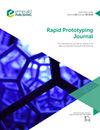高性能生物乙醇燃料电池中3D打印流道板的设计优化
IF 3.6
4区 工程技术
Q1 ENGINEERING, MECHANICAL
引用次数: 0
摘要
目的直接乙醇燃料电池(FC)堆的有效性能取决于其单个电池的满意运行,其中管理温度梯度、水流和反应物的分布总是很有挑战性的。其中,双极燃料流路板的设计对实现上述参数起着至关重要的作用。此外,双极板占其重量的80%,占其总成本的30%-40%。本研究的目的是提高燃料-能源转换的效率,并将总生产成本降至最低。设计/方法/方法作者专门设计、模拟和制造了一个标准的2.5×2.5cm2活性面积质子交换膜(PEM)FC流道板,通过改变单梯、双梯和叉指型和可变通道几何形状(即半曲线、三角形和矩形)中的流场来研究其性能。发现使用3D PEMFC模型并可视化FC运行过程中发生的物理和电化学过程,可以实现更好的流道板设计。它是利用增材制造技术制造的。此外,具有所设计的流路板的全电池的组装显示出总重量减少了约11.44%,这对其总成本以及堆叠电池中的比能量密度有重要影响。独创性/价值同时优化多个流道参数以获得更好的性能是这项研究的标志,它提高了能量密度,降低了设备生产成本。本文章由计算机程序翻译,如有差异,请以英文原文为准。
Design optimization of 3D printed flow path plates in high-performance bioethanol fuel cells
Purpose
Effective performance of a direct ethanol fuel cell (FC) stack depends on the satisfactory operation of its individual cells where it is always challenging to manage the temperature gradient, water flow and distribution of reactants. In that, the design of the bipolar fuel flow path plate plays a vital role in achieving the aforementioned parameters. Further, the bipolar plates contribute 80% of the weight and 30%–40% of its total cost. Aim of this study is to enhance the efficiency of fuel to energy conversion and to minimize the overall cost of production.
Design/methodology/approach
The authors have specifically designed, simulated and fabricated a standard 2.5 × 2.5 cm2 active area proton exchange membrane (PEM) FC flow path plate to study the performance by varying the flow fields in a single ladder, double ladder and interdigitated and varying channel geometries, namely, half curve, triangle and rectangle.
Findings
Using the 3D PEMFC model and visualizing the physical and electrochemical processes occurring during the operation of the FCs resulted in a better-performing flow path plate design. It is fabricated by using additive manufacturing technology. In addition, the assembly of the full cell with the designed flow path plate shows about an 11.44% reduction in total weight, which has a significant bearing on its total cost as well as specific energy density in the stack cell.
Originality/value
Simultaneous optimization of multiple flow path parameters being carried out for better performance is the hallmark of this study which resulted in enhanced energy density and reduced cost of device production.
求助全文
通过发布文献求助,成功后即可免费获取论文全文。
去求助
来源期刊

Rapid Prototyping Journal
工程技术-材料科学:综合
CiteScore
8.30
自引率
10.30%
发文量
137
审稿时长
4.6 months
期刊介绍:
Rapid Prototyping Journal concentrates on development in a manufacturing environment but covers applications in other areas, such as medicine and construction. All papers published in this field are scattered over a wide range of international publications, none of which actually specializes in this particular discipline, this journal is a vital resource for anyone involved in additive manufacturing. It draws together important refereed papers on all aspects of AM from distinguished sources all over the world, to give a truly international perspective on this dynamic and exciting area.
-Benchmarking – certification and qualification in AM-
Mass customisation in AM-
Design for AM-
Materials aspects-
Reviews of processes/applications-
CAD and other software aspects-
Enhancement of existing processes-
Integration with design process-
Management implications-
New AM processes-
Novel applications of AM parts-
AM for tooling-
Medical applications-
Reverse engineering in relation to AM-
Additive & Subtractive hybrid manufacturing-
Industrialisation
 求助内容:
求助内容: 应助结果提醒方式:
应助结果提醒方式:


